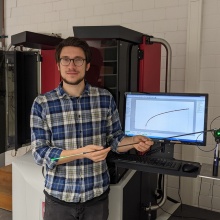Catalysts with a metal-nitrogen bond can transfer nitrogen to organic molecules. In this process short-lived molecular species are formed, whose properties critically determine the course of the reaction and product formation. The key compound in a catalytic nitrogen-atom transfer reaction has now been analysed in detail by chemists at the Universitis of Göttingen Frankfurt and Stuttgart. The detailed understanding of this reaction will allow for the design of catalysts tailored for specific reactions. The renowned journal Nature Chemistry reported on this.
The development of new drugs or innovative molecular materials with new properties requires specific modification of molecules. Selectivity control in these chemical transformations is one of the main goals of catalysis. This is particularly true for complex molecules with multiple reactive sites in order to avoid unnecessary waste for improved sustainability. The selective insertion of individual nitrogen atoms into carbon-hydrogen bonds of target molecules is, for instance, a particularly interesting goal of chemical synthesis. In the past, these kinds of nitrogen transfer reactions were postulated based on quantum-chemical computer simulations for molecular metal complexes with individual nitrogen atoms bound to the metal. These highly reactive intermediates have, however, previously escaped experimental observation. A closely entangled combination of experimental and theoretical studies is thus indispensable for detailed analysis of these metallonitrene key intermediates and, ultimately, the exploitation of catalytic nitrogen-atom transfer reactions.
Chemists in the groups of Professor Sven Schneider, University of Göttingen, and Professor Max Holthausen, Goethe University Frankfurt, in collaboration with the groups of Professor Joris van Slagern, University of Stuttgart and Professor Bas de Bruin, University of Amsterdam, have now been able for the first time to directly observe such a metallonitrene, measure it spectroscopically and provide a comprehensive quantum-chemical characterization. To this end, a platinum azide complex was transformed photochemically into a metallonitrene and examined both magnetometrically and using photo-crystallography. Together with theoretical modelling, the researchers have now provided a detailed report on a very reactive metallonitrene diradical with a single metal-nitrogen bond. The group was furthermore able to show how the unusual electronic structure of the platinum metallonitrene allows the targeted insertion of the nitrogen atom into, for example, C–H bonds of other molecules.
Stuttgart measurements contribute to detailed understanding
The Van Slageren group at the Institute of Physical Chemistry at the University of Stuttgart has investigated the magnetic properties of a unique platinum compound produced in the group of Prof. Schneider from Göttingen. The compound is a long-sought, elusive intermediate in important chemical reactions. The Stuttgart measurements have helped to understand the properties of this intermediate in detail. For this purpose, a novel structure had to be developed to create the platinum compound within the measuring device. "Changing our measurement setup so that we could measure this fragile compound was really cool," says David Hunger, the PhD student who performed the measurements. Van Slageren says: "This collaboration showed once again that the combination of expertise leads to significant added value in research".
The research was funded by the Deutsche Forschungsgemeinschaft and the European Research Council.
Original Publication::
Jian Sun, Josh Abbenseth, Hendrik Verplancke, Martin Diefenbach, Bas de Bruin, David Hunger, Christian Würtele, Joris van Slageren, Max C. Holthausen, Sven Schneider: A platinum(II) metallonitrene with a triplet ground state. Nat. Chem. (2020) https://doi.org/10.1038/s41557-020-0522-4
| Contact | Prof. Joris van Slageren, Institute of Physical Chemistry, Phone +49 711 685 64380, E-Mail e-mail |
|---|


